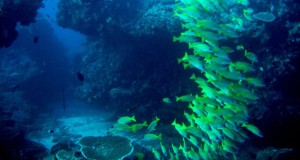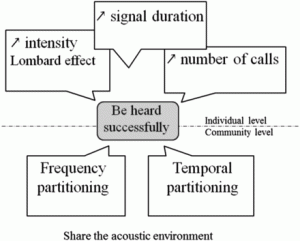Most people know that humans are having an effect on the environment. Through pollution, overpopulation, and habitat destruction, we’re already impacting the way many animals live. Lately, people have realized another way we’re changing nature: by adding sound. Noise pollution makes it difficult for animals to hear calls or predators. It also makes being heard difficult, which makes finding a mate less likely.
Fortunately, new recording techniques have made the study of the aquatic soundscape (all the noises in a given area) much easier to do. Passive acoustic recording devices can be placed and left at great depths, and for longer periods of time than a human could remain underwater. The process involves placing one or more small recording devices, and scheduling them to record at specific times throughout the day and night.
Want to know what a fish sounds like? Follow this link to a Haddock spawning call: link
One recent study aimed to investigate the soundscape 120 meters off the coast of Sodwana Bay in South Africa. Many species of fish live there in underwater caves—over 200, at last count. Researchers placed passive acoustic recording devices in a cave called Jesser Canyon, and set tem to record for nine minutes every ten minutes for 19 days over the course of two months. In the sound data the collected, 37 different species were heard. Seventeen were clear enough to be followed for 15 days so that their patterns of calling could be observed.

Fish swim from one of the beautiful underwater caves in Sodwana Bay. Source
They found that some fish called at night, while others call during the day. This isn’t surprising, as many fish are nocturnal, but what is surprising is the lack of overlap in nighttime calls. Fish who call during the day had no problem talking over each other, likely because they could get the attention of whoever they were calling to with a visual display. At night, however, when it’s too dark to see, fish avoid confusion by not overlapping calls. This is called “temporal partitioning,” and refers to separating calls in time.

Image from paper illustrating the different methods individuals and communities use to be heard above the din. Source
This is interesting because it’s been observed in birds and frogs, but not fish. Fish and birds may avoid noise pollution by spacing out their calls and making them distinct. It’s like waiting for a lull in the conversation of a full room before making an announcement. Everyone can hear better that way. Future research will investigate if fish also use other methods seen in other species, such as increasing volume or using a different frequency.
Reference:
Ruppé, L., Clément, G., Herrel, A., Ballesta, L., … and Parmentier, E. (2015).
Environmental constraints drive the partitioning of the soundscape in fishes
PNAS 112(19): 6092-6097.
